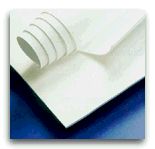Expanded PTFE
Today with the introduction of reasonably priced Expanded PTFE sheet gasket materials (EPTFE), one material can solve a great majority of the gasket applications out there. Gaskets cut from EPTFE are good for both hot applications to 650 F (peek) 500 F Continuous and cryogenic applications. So hot or cold your good. Gasket material inventories can be reduced by eliminating all the various styles required for an industrial plant. For example:
HVAC systems (cryogenic) often required an Neoprene based non-asbestos - Expanded PTFE Seals it !
Oil Systems required a Nitrile based gasket material - Expanded PTFE Seals it !
Steam systems required an EPDM rubber based non-asbestos - Expanded PTFE Seals it!
Water - Waste Water required red rubber, gum rubber, non-asbestos - Expanded PTFE Seals it!
Chemical Applications required Viton, FKM, FFKM, Kalrez - Expanded PTFE Seals it!
Food and beverage applications required FDA approved rubber, or PTFE - Expanded PTFE meets the FDA requirements!
Potable water (for human consumption) applications required NSF approved materials - Expanded PTFE meets NSF!
Glass Pipe and low bolt load applications have been sealed with special low durometer rubber or cork and rubber blends - Expanded PTFE seals them too!
It’s not uncommon for a plant to have in stock 7 - 10 different gasket materials. The cost of buying small quantities of each, plus the chance for mistakenly using the wrong material, makes standardizing on EPTFE (expanded PTFE) the smart thing to do. Installing the wrong gasket material, many of which look nearly identical (Nitrile and Viton (black)). The result can be lost production, lost time, lost product, or physical injury.
Another form of expanded PTFE is known as joint sealant. If you need a gasket on the spot, joint sealant allows you to unroll the EPTFE and attach it to the flange (with the included peel and stick adhesive on one side). Instant gaskets, ideal for fast in the field repairs.
There are applications that still need a base of rubber material to provide recovery EPTFE does not have. Thermodynamic applications for example can be a problem, depending on the range of temperature and the speed of the transition. Flanges that are repeatedly opened and closed often also require rubber that provides recovery. For this applications we have solutions just contact support@aspseal.com
Today, most shops can get by with just Expanded PTFE, unless they are dealing with the above mentioned applications, or temperatures over 500F. In high temp applications flexible graphite is very much like expanded PTFE in that is will cover most applications with a short list of exceptions. Unlike expanded PTFE it is more difficult to handle (only thin sizes can be rolled and are very fragile). Flexible graphite also can be difficult to cut due to metal inserts. |


